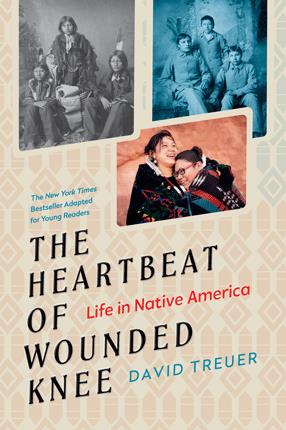| Heartbeat of Wounded Knee : life in Native America Author: Treuer, David | ||
| Price: $6.50 | ||
Summary:
Since the late 1800s, it has been believed that Native American civilization has been wiped from the United States. The Heartbeat of Wounded Knee argues that Native American culture is far from defeated--if anything, it is thriving as much today as it was one hundred years ago. The Heartbeat of Wounded Knee looks at Native American culture as it exists today--and the fight to preserve language and traditions.
| Added Entry - Personal Name: | Keenan, Sheila |
Reviews:
School Library Journal (11/01/22)
Booklist (+) (11/01/22)
Full Text Reviews:
Booklist - 11/01/2022 *Starred Review* Yes, it’s another adaptation for young readers of an adult best-seller, but this one is special, for it offers an examination of an essential subject: life in Indigenous America. The Ojibwe author seamlessly addresses his material in a hybrid fashion that’s part history, part reportage, and part memoir, and Keenan ensures all is accessible to a younger audience. The fascinating subject is presented in rough chronological order from 10,000 BCE to today, although Treuer’s primary focus is on the period since the tragic 1890 massacre at Wounded Knee. He begins by surveying Native history geographically (i.e., the Northeast, the Great Basin, etc.) and then moves to a more chronological and topical strategy (e.g., The “Indian Problem,” 1891–1934). For Native Americans, the problems they faced, more often than not, resulted from dealings with the U.S. government, which Treuer finds to have been feckless, cruel, shortsighted, hypocritical, and shameful. Obviously, Treuer pulls no punches, concluding that “our Indian cultures are not dead, and our civilizations have not been destroyed”—as this excellent book demonstrates. Archival photographs and historical documents, such as a Bureau of Indian Affairs relocation brochure, pepper the text, which is further supported by copious source notes. The history related here is necessary for all Americans to understand, and Treuer’s personalized accounting ensures that readers will learn it with both their minds and hearts. - Copyright 2022 Booklist.
School Library Journal - 11/01/2022 Gr 9 Up—This is a book about the lives, identity, and trials of the Indigenous peoples of North America. Indigenous author Treuer's The Heartbeat of Wounded Knee, a National Book Award finalist, has been reworked for young adults. Treuer emphasizes that this book is about identity and the ability of Indigenous people to exist on their own terms. The book moves forward in time starting with pre-contact Indigenous peoples and ends in our current era. Each chapter highlights the struggle of Indigenous people in the face of relentless colonialism, government-sanctioned violence, and many other social calamities. This work is an excellent source for young people to explore counter-narratives of North American history—settler society has long controlled the lens. As Treuer writes, "it is an attempt to confront the ways we Indians ourselves understand our place in the world. We carry within us stories of our origins, and ideas about what our families, clans, and communities mean. But too often we agree with the way in which we are read by outsiders." VERDICT A well-researched approach to North American history that features personal narratives from Indigenous Americans.—Meaghan Nichols - Copyright 2022 Publishers Weekly, Library Journal and/or School Library Journal used with permission.
Booklist - 11/01/2022 *Starred Review* Yes, it’s another adaptation for young readers of an adult best-seller, but this one is special, for it offers an examination of an essential subject: life in Indigenous America. The Ojibwe author seamlessly addresses his material in a hybrid fashion that’s part history, part reportage, and part memoir, and Keenan ensures all is accessible to a younger audience. The fascinating subject is presented in rough chronological order from 10,000 BCE to today, although Treuer’s primary focus is on the period since the tragic 1890 massacre at Wounded Knee. He begins by surveying Native history geographically (i.e., the Northeast, the Great Basin, etc.) and then moves to a more chronological and topical strategy (e.g., The “Indian Problem,” 1891–1934). For Native Americans, the problems they faced, more often than not, resulted from dealings with the U.S. government, which Treuer finds to have been feckless, cruel, shortsighted, hypocritical, and shameful. Obviously, Treuer pulls no punches, concluding that “our Indian cultures are not dead, and our civilizations have not been destroyed”—as this excellent book demonstrates. Archival photographs and historical documents, such as a Bureau of Indian Affairs relocation brochure, pepper the text, which is further supported by copious source notes. The history related here is necessary for all Americans to understand, and Treuer’s personalized accounting ensures that readers will learn it with both their minds and hearts. - Copyright 2022 Booklist.




